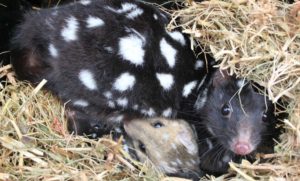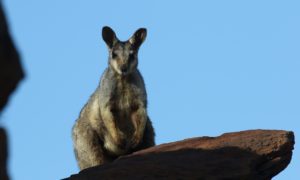World Wildlife Day: The impact we can have on a big and small scale
Stannah talks about conservation, and shares a heart-warming story about a customer who took his pet’s well-being to the next level.
Written by Stannah

- Australian wildlife
- Helping animals closer to home
- A pet-friendly stairlift overlooking the Amsterdam canals
- Common Ailments in Senior Dogs
- Warning signs that your senior dog could have arthritis.
- What can you do to help your dog with arthritis?
- A stairlift for the entire family, human or not!
This World Wildlife Day, the theme is endangered big cats. It might seem like these predators are a world away from the wildlife we see here in Australia, but WWF-Australia don’t just work within our borders. They also work within the Asia-Pacific region and they’re making a huge difference! Their conservation projects have the ambitious goal of doubling the number of wild tigers by the year 2022, and there are lots of ways you can help by getting involved:
- Spread the message – tell everyone you know about the danger tigers are facing
- Think green – be aware of where your products come from – they could be having a detrimental impact on tigers’ habitats
- Be aware of the illegal wildlife trade – don’t buy anything made from parts of a tiger’s body

Australian Wildlife
Just because the focus of World Wildlife day is on big cats doesn’t mean we can’t also take this day to think about our own wildlife. We all know how unique Australian fauna is, and how important it is to protect our furry friends. But the sad matter of it is that our mammal population is dwindling, and some of our smaller animals are in danger of decline or even extinction. Fire, introduced predators, habitat degradation and competition for food are only some of the struggles our wildlife is facing, and there are little things we can do to help.
Threatened species include:
- Woylies
- Numbats
- Bandicoots
- Bilbies
- Quokkas
- Quolls
- Rock-wallabies
How can you help?
Numbats
 It is estimated that there are fewer than 1,000 numbats in the wild today. They’re very hard to spot, and very shy animals, so it’s very hard to know how they’re doing. If you want to help conserve this impressive creature, look out for them! Once the WWF know where their habitats are, they can work to protect them.
It is estimated that there are fewer than 1,000 numbats in the wild today. They’re very hard to spot, and very shy animals, so it’s very hard to know how they’re doing. If you want to help conserve this impressive creature, look out for them! Once the WWF know where their habitats are, they can work to protect them.
Seen a numbat? Send in your numbat sighting, along with a date, GPS location and contact details to fauna@dbca.wa.gov.au
@John Lawson WWF-Aus http://www.wwf.org.au/images/carousel/5c1a5cb3-6e83-4cd0-b6ea-f69162d1a4de_img-numbat-log-1000px.jpg

Eastern Quolls
The Eastern Quolls are being re-introduced into mainland Australia, where they’ve been extinct for 50 years. Introduced predators like foxes and cats are being managed to give the quolls a fighting chance. To help with this project, you can donate to the WWF and spread the word about this happy homecoming!
@Madeline Smitham WWF-Aus http://www.wwf.org.au/images/carousel/c218ba57-4358-475b-a26a-5a52f8fc79fe_img-mother-quoll-with-pups-1000px.jpg
Rock-wallabies

Rock wallabies are facing extinction due to habitat destruction, predation by foxes and cats and competition for food and shelter.
The WWF is working hard to help this beautiful species, and partnered with the Western Australian givernment to build a predator-proof fence in the Western Australian Wheatbelt that keeps the wallabies safe from predators. This simple solution means the world to this special creature.
Helping Animals closer to home
The conservation efforts of the WWF and other similar organisations are inspiring, but sometimes it all just feels that little bit too distant. It may feel like there’s nothing one single person can do to help all the animals in danger of extinction. But there may be one or two animals you can help a bit closer to home… maybe even in your home!
We’re happy to share an inspiring story that will surely make your day! But why would Stannah – a stairlift company – be so interested in World Wildlife Day?
We are all responsible for promoting a compassionate culture towards animals and, as pet owners, we need to be aware that animals like cats and dogs also face the inevitable ordeals of aging. At Stannah, we believe it is important to provide a voice for those who have none. That is why Stannah advocates for the advancement of animal welfare standards and respect for their status as sentient beings.
In fact, with all the scientific advances and medical care, our pets are also living longer, so we’ll have to make sure that we provide all the necessary health care, in order to ensure their well-being as they age.
Stannah is known for taking their customers’ needs to the next level, so why shouldn’t that include our customers’ pets?
Hopefully, this story will inspire others to take their pets wellbeing to the next level.

A pet-friendly stairlift overlooking the Amsterdam canals
World Wildlife Day is an international event, celebrated around the world, so it’s fitting that we tell the story of one of our Dutch customers and his lucky pet, who got his very own stairlift! Nico Kool, lives in a beautiful house overlooking the Amsterdam canals. The houses are known to be steep and narrow, especially the staircases, as many of them date back as far as the 17th century.
“I have a Labrador Retriever. I used to have a Labrador before as well and they tend to have a lot of issues with their joints, resulting in arthritis as they grow older,” Nico told us. Arthritis and other joint related ailments are very common in dogs, resulting in pain and reduced mobility. Nico decided that a stairlift would be a perfect solution for his Labrador and the rest of this family, and as his mother in law comes to visit often, she can benefit from the stairlift too.
Nico was impressed with Stannah’s work method. On the first visit, it was clear to him how the stairlift would look and how the installation would be done.
“We wanted to avoid him not being able to climb up and down the stairs when they do become an issue.”
On the day of the installation, the technicians were able to complete the entire project in just one morning. Nico was so surprised that he and his dog could use the stairlift that same afternoon! As you can tell from the video, the pup sure is happy with his new method of transportation, it even tastes good! Did he choose the bacon flavored upholstery?
https://youtu.be/Q9vooPnNomw
Common Ailments in Senior Dogs
As wildlife photographer and author, Roger Caras once said, “Dogs are not our whole life, but they make our lives whole”. Dogs are now, more than ever, true members of our families. They bring so much joy and love to our homes, that there’s just no denying it.
Just like us, our beloved canine friends are aging and dealing with the ailments and struggles that come along with growing older. What can we do to help them? Osteoarthritis, also known as degenerative arthritis, is a common condition in dogs characterized by progressive deterioration of articular cartilage in the joints of the limbs. It can cause a great deal of pain and lameness.
Arthritis in dogs is one of the most common doggy health issues out there, but sometimes it can be difficult to diagnose joint-related issues, as dogs tend to ignore discomfort and even pain until it is really too much for them to endure.
Warning signs that your senior dog could have arthritis.

If your senior dog shows the following symptoms, he or she might be suffering from a degenerative joint disease (DJD), or osteoarthritis. Here are some signs to consider:
- Doesn’t play with his/her usual toys.
- Is scared to climb up and down the stairs.
- Is not as enthusiastic as he/she used to be.
- Wants to go home sooner than usual during daily walks.
- Lies down more than usual, the lying down is accompanied by a groan.
- Can’t jump up on the couch/ into the car, or the dog clearly hesitates prior to jumping.
If you´ve noticed some, or all of the signs above, we recommend you make an appointment with your veterinarian just to be safe. Also, if you´re not sure, it’s always better to be safe than sorry!
What can you do to help your dog with arthritis?
Your vet really is the best person to help you and your dog, however, there are some strategies you can do yourself that could be beneficial. We found some advice from a vet that could help relieve your dog´s arthritis. Some things you could do to help include:
- Invest in some non-skid flooring.
- Avoid putting your dog´s bed in cold or damp spaces.
- Get padded steps or a ramp to get on and off the bed.
- Give your dog muscle massages to stimulate blood flow to atrophying muscles.
- Glucosamine or Chondroitin supplements can be beneficial as well, but just as with humans, this is not guaranteed to help.
- Exercise, it’s important that your dog exercises every day at his or her own pace. Swimming is also beneficial as it puts much less pressure on the joints.
- Pharmaceutical, there are many options when it comes to drugs. This is best looked at together with your vet, who will be more of an expert on this subject.
- Surgery, and treatment with NSAID´s and corticosteroids (a class of steroid hormones).
- Other treatment with warm compresses or acupuncture.
- If you have stairs in your home, installing a stairlift is, of course, ideal as we saw with the Dutch lab.
A stairlift for the entire family, human or not!
The video shows us how helpful a stairlift can be for both a dog and his family. His owner kept him on his lap while they glided up and down the stairs together. The stairlift is perfectly capable of transporting your pet in this way.
Pet owners typically buy stairlifts for dogs, as they tend to have more joint related issues. However, other pets, like cats, could also hitch a ride on the family stairlift!
Learn more about our stairlifts:
https://stannah.com.au/
